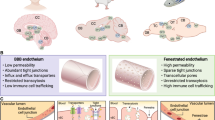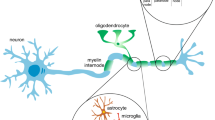Synopsis
The amount of Luxol Fast Blue MBS in the band of Genarri was measured with two types of scanning microdensitometer and the optical density determined. The amount of stain measured was proportional to the section thickness employed, thus demonstrating that the dye has stoichiometric properties in tissue sections. Blocks of tissue treated with phospholipid solvents showed an increased uptake of stain, suggesting that phospholipids are not a primary substrate for the dye in myelin staining.
The dye may, therefore, be used to quantify myelin in tissue sections.
Similar content being viewed by others
References
Adams, C. M. W. &Davison, A. N. (1965). The Myelin sheath: In:Neurohistochemistry (ed. C. M. W. Adams) pp. 332–400. New York: Elsevier.
Amaducci, L. (1961). VII International Congress of Neurology, Rome, quoted by Folch-Pi, J. In:Brain Lipids and Lipoproteins and the Leucodystrophies (eds. J. Folch-Pi & H. Bauer), pp. 22 & 23. Amsterdam: Elsevier.
Chaubel, K. A. Ledin, Z. &Pilny, J. (1967). A new approach to the determination of thickness of biological specimens by two wavelength method using Interference Microscopy.Acta histochem. bd. 26, 5, 131–43.
Clasen, R. A., Simon, R. G., Scott, R., Pandolfi, S., Laing, I. &Lesak, A. (1973). The staining of the myelin sheath by Luxol dye techniques.J. Neuropath. exp. Neurol. 32, 271–283.
Heslinga, F. J. M. &Deierkauf, F. A. (1962). The action of formaldehyde solutions on human brain lipids.J. Histochem. Cytochem. 10, 704–9.
Kluver, H. &Barrera, E. (1953). A method for the combined staining of cells and fibres in the nervous system.J. Neuropath. exp. Neurol. 12, 400–3.
Kluver, H. &Barrera, E. (1954). On the use of azo porpin derivatives (phthalocyanins) in staining nervous tissue.J. Psychol. 37, 199–223.
Lycette, R. M., Danforth, W. F., Kopel, J. L. &Olwin, J. H. (1966). Surface uptake of the azo dye Luxol Fast Blue ARN by human platelets.Can. J. Biochem. 44, 161–70.
Lycette, R. M., Danforth, W. F., Kopel, J. L. &Olwin, J. H. (1970). The binding of Luxol Fast Blue ARN by various biological lipids.Stain Technol. Vol.45, No. 4, 155–60.
Mann, D. M. A. &Yates, P. O. (1973). Polyploidy in the Human Nervous System. Part I. The DNA content of neurones and glia of the cerebellum.J. Neurol. Sci. 18, 183–96.
Salthouse, T. N. (1962). Luxol Fast Blue ARN. A new solvent azo dye with improved staining qualities for myelin and phospholipid.Stain Technol. 37, 313–6.
Salthouse, T. N. (1964). Luxol Fast Blue G as a myelin stain.Stain Technol. 39, 123.
Struve, W. S. (1955). Phthalocyanine dyes. In:The chemistry of synthetic dyes and pigments (ed. H. A. Lubs) p. 607. New York: Reinhold Pub. Corp.
Author information
Authors and Affiliations
Rights and permissions
About this article
Cite this article
Scholtz, C.L. Quantitative histochemistry of myelin using Luxol Fast Blue MBS. Histochem J 9, 759–765 (1977). https://doi.org/10.1007/BF01003070
Received:
Revised:
Issue Date:
DOI: https://doi.org/10.1007/BF01003070




